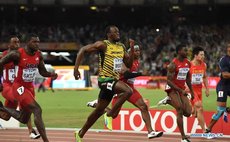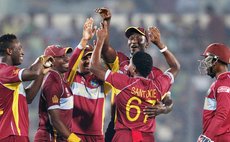The bricks and mortar of a good cricket team - part 3
Basic stroke play
In all ball games an invariable precept is that of keeping one's eye on the ball. The legendary Everton Weeks amplified this even further. He said, as a batsman you could stay at one end of the batting strip and focus so intently at the stumps at the bowler's end to the extent that you might actually see them bigger than you normally see them. To this effect you could rivet your attention on the ball in the bowler's hand to the point of magnifying the approaching object. Weeks also hinted to young batsmen: "if you can hear the crowd, you are not suitably well focused while at the crease"! You may find this bordering on being paranoid to a degree. However, Mr. Weeks is the holder of a unique record in Test cricket. He scored five centuries in successive Test innings and was adjudged run-out for 90 in the sixth innings.
Remember our assumption that the reader would be a right handed batsman for our purposes. The left hand provides control of the direction in which the bat moves in the drives. The right hand contributes the required power. Obviously, the feet should be aligned so the bat can move freely. For the average youngster it is important to think in terms of power rather than strength. Without making it sound unduly technical, it is the speed with which the bat moves just prior to its contact with the ball allied to a precise control of the shot which gives effective power and relatively risk free performance in the drive. Accordingly, a small man or boy can develop the knack of dispatching fast but over-pitched deliveries to the boundary. This is, of course, easier said than done. Yet, much good practice will make this quite possible.
Execution of the drive demands proper positioning and keeping the head still. Failure to keep the head from rocking up or down or sideways tends to ruin the drive. Ideally, the ball should be struck at a point where the head is just over the ball - with the hands carrying the bat through the line of the ball.
Where the batsman intends to go through with the drive when he is not quite to the pitch of the ball he should employ the technique of carrying the hands in the modified posture of the left elbow raised high. Needless to say, this shot labelled as hitting on the rise is greatly assisted by the friendliness of a concrete batting surface in team practices. Usefully, you should remember to allow the ball to come to you. In any case, all your shots ought to be high percentage ones. Avoid those you haven't mastered adequately in practices.
A very useful ally to all serious batsmen is the art of reading the intentions of the bowler for each specific delivery. This is aided by overseeing the position of the seam of the ball, the bowlers grip and his hand movement. This demands much practice and, perhaps, trial and error. Bear in mind the place for this trial and error has to be the practice session and not the actual match – before which you should have already ironed out your approach fully.
Very common mistake made by young promising batsmen is trying to repeat a spectacular drive to a ball which isn't there for a safe negotiation in this regard. Always be on your guard. A beautiful shot sets the bowler thinking afresh and he will always try to deceive you by employing some sort of variation which conceals deception in pace length or line.
Wonderful piece of advice is to avoid hitting in the air unless it is safe to do so. Remember you can't be caught when the ball is played along the ground. Even a batsman as powerful as Darren Sammy has often enough fallen into the trap of arrogance in disrespecting the deep set fielders. The result is an unnecessary loss of a wicket at least convenient times. Patience here is a vital precept. Let the bowler bowl on your terms. You can always wait for the next delivery which suits your purpose!
Whatever the disposition of a young batsman, there is always need to temper aggression with discretion, which means there are always periods of defense where the stealing of singles should predominate. One of the surest ways of achieving this is through deflection of the ball through the in-field. Fatal mistake here is an attempt to move the bat across the line to pitched up deliveries. The vigilant batsman plays straight while employing a wristy turn at the movement of contact with the ball. Better to endure restriction to a few singles than to suffer a premature end to a promising situation. Patience and continued focus is the answer. Wait long enough - the bowler will tire or be replaced, no matter how accurate he might be. Bat on your terms.
What does the batsman do in adjusting to the right arm bowler switching from over the wicket to around the wicket or when he is replaced by a left arm bowler? The batsman may counter by taking a slightly different batting guard from the umpire. In this context he may elect to assume a stance as much as a foot or more outside the batting crease. Many have adopted this to counter a bowler who includes a strong diet of Yorkers in his armory. Many of his attempted Yorkers can be met as over-pitched deliveries.
If overall team development calls for a longer and stronger batting lineup there is an absolute need for the batting to extend well down to at least Nº 9 or 10. This should be met by two ways – bowlers should, in addition to being specialists with the ball, assume serious batting responsibilities. Conversely, a couple of specialist batsmen should opt to broaden their usefulness by also developing into high quality change bowlers.
It is all a matter of careful and systematic addition to technical capabilities of willing individuals. From what has gone before, there is supreme requirement for a number of useful considerations to be met. As indicated earlier in this series of articles, a concrete practice batting strip is a vital necessity. The strip can be diversified with greater width of the nets into three bays so that three batsmen can bat simultaneously. At the same time this allows provision for adequate batting time for specialist bowlers to develop their proficiency with the bat.
Over and beyond the advice offered in this series, it is sincerely to be hoped our television stations will see the usefulness of offering public service by screening the pretty well documented COACHING VIDEO entitled CRICKET THE WEST INDIES WAY. A goodly sponsor should be encouraged to get into the picture to facilitate this. Otherwise we continue to beat the air with much words for unending years.




